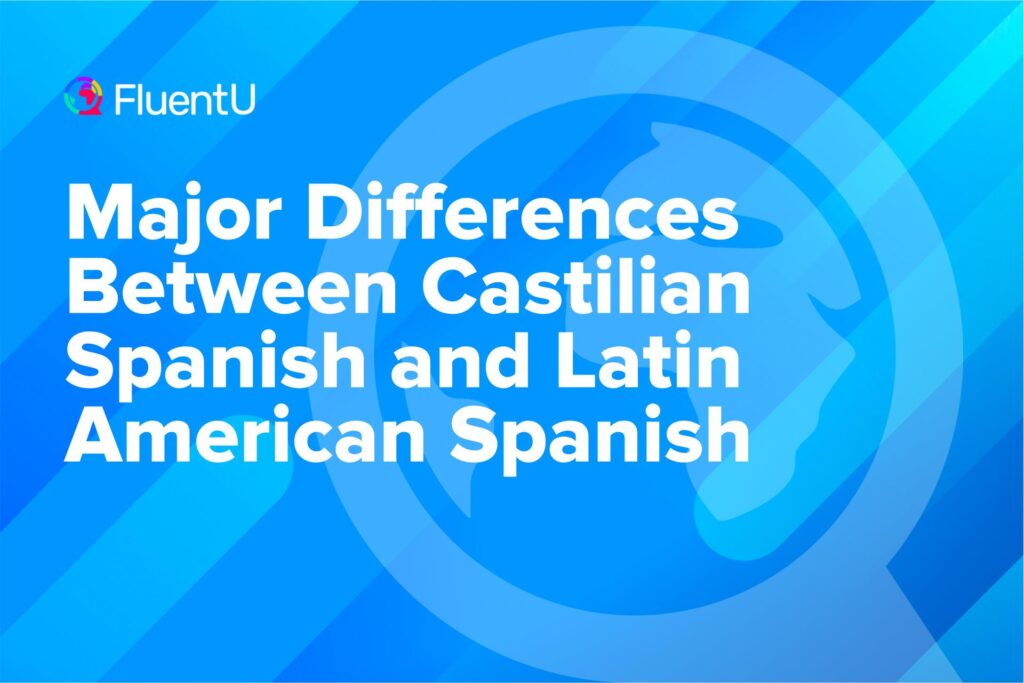Contents
- 1. Modes of Address: Use of Ustedes vs Vosotros
- 2. Use of Usted vs Vos vs Tú
- 3. Variations in Accent and Pronunciation
- 4. Leísmo and Object Pronoun (Mis)use
- 5. Main Vocabulary Differences
Major Differences Between Castilian Spanish and Latin American Spanish

Spanish is a complex language that has evolved and matured in geographically and culturally disparate locations. As a consequence, there are some significant differences in accents, grammar, vocabulary, slang and idioms in different parts of the Spanish-speaking world.
In this post, we’ll narrow our focus to examine some of how Spanish from Spain (referred to as Peninsular, European or Castilian Spanish) is different from the Spanish spoken in the Americas (broadly referred to as Latin American Spanish). We also cover these points in this lesson from our YouTube channel:
Download: This blog post is available as a convenient and portable PDF that you can take anywhere. Click here to get a copy. (Download)
1. Modes of Address: Use of Ustedes vs Vosotros
In Spanish, there are officially five different ways in which you can address people.
There are the three singular forms tú, vos and usted, which correspond to the English “you.” These each have varying degrees of formality. There are also the two plural forms, vosotros and ustedes, which are used when speaking to two or more people.
But hold on a moment, there’s a catch, and an important one at that!
- In Latin American Spanish, when it comes to the plural forms, only one of them is in fact used—ustedes. This is perhaps the most important and most often cited difference between Peninsular and Latin American Spanish, so pay attention.
- In Peninsular Spanish, when you address two or more people, you have a choice to use either vosotros or ustedes as your mode of address. Which one you use is influenced by a number of factors including formality of context, degree of respect wishing to be demonstrated and the level of intimacy you have with whom you are speaking.
Vosotros
For most normal day-to-day circumstances, vosotros is the order of the day and you’ll hear it a lot in Spain.
If you’re familiar with the people you’re addressing, you use vosotros and any verb conjugation and pronoun use will follow its associated rules. Even if you’re not familiar with these people, you’ll still use vosotros if they’re of a similar age to you, or if there’s no particular requirement to afford them special respect.
Ustedes
Conversely, in Spain, the use of ustedes is restricted to more formal occasions or circumstances where demonstrations of respect are required.
For example, if you were speaking to the board of directors at work, a group of political figures or the royal family in all their glory, you’d stick to using ustedes. No doubt you can think of some other situations where it might be appropriate to use this.
In contrast, in Latin American Spanish, these types of distinctions aren’t a concern as you only have one choice, ustedes. It doesn’t matter if you’re speaking to your best friends, your parents or the most important group of people on earth.
The vosotros form is never used in Latin America (aside from Argentina) and in fact faded out of use completely from Latin American Spanish by the end of the 19th century.
It’s worth remembering that even native speakers from Latin America who go to Spain often have trouble with it and will generally stick to using ustedes, so don’t feel too bad if initially you do too! You’ll certainly be understood, however, you might find yourself being corrected.
2. Use of Usted vs Vos vs Tú
Following on from above, it should come as no surprise that the use of usted in Spain is also restricted for more formal occasions and follows the same guidelines as outlined for its plural form. From personal experience, I only recall ever being addressed as usted once in Spain when attending a medical clinic.
Most of the time, tú will suffice for all normal instances. However, you’ll need to use your discretion.
Conversely, in Latin American Spanish, usted is much more commonly used. Specifics of usage will tend to change slightly depending on which particular country you’re in and thus there’s no one-size-fits-all rule. As a general guideline though, it’s usually a good idea to address anybody you don’t know in the usted form.
In Latin American Spanish, if you start with usted you may be invited to tutear with the speaker—that is, to address them in tú form. In some countries such as Argentina, Uruguay, Paraguay, and in parts of Colombia and Central America, you’ll instead be asked to vosear, which means to address them in the form of vos (a variation on tú, but equally informal).
More often than not, you won’t get a direct invitation to change over to the other verb form—you’ll just have to listen carefully and pick up on what verb form your conversation partner has decided to use with you.
It’s worth noting that the use of usted is as much a cultural as a linguistic phenomenon. Generally, there’s a strong tendency for politeness in Spanish-speaking Latin American countries. If you address people using the tú or vos form without invitation, it might be interpreted as impolite or overly familiar.
Having said that, it’ll also depend with whom you’re speaking. Generally, if you’re speaking with younger people, using tú or vos will be fine, as they tend to use these forms more.
It may seem a little complex initially, but if you use your listening skills to pay close attention to how those around you speak, you’ll quickly be able to pick up the best form of address in the area you’re in and you’ll be speaking like the locals in no time.
3. Variations in Accent and Pronunciation
An entire volume could be written on the array of different accents which are found in the Spanish-speaking world. Even within countries, accents can vary quite wildly, with changes observable between coastal regions, cities and rural areas.
Luckily for us learners, although accents can change radically, pronunciation of words between variants of Spanish remains for the most part very similar. That being said, there are a couple of differences worth looking at.
Distinción
The most noteworthy of those is referred to in linguistics as distinction (distinción).
Many speakers of Spanish in Spain (but not all) have a tendency to pronounce the c which comes before i and e as a th sound. The z, regardless of position, is also pronounced as a th sound. This is what distinción refers to.
A less kind interpretation and occasional source of amusement for native Spanish speakers from other countries is to suggest that it sounds like a lisp. It’s not actually a lisp, but rather a distinct form of pronunciation and is equally correct.
Seseo
Latin American Spanish speakers do not produce this sound. This Latin American pronunciation, not using the th sound, is described linguistically as seseo.
Take for example the word gracias—in Latin America, along with a sizable part of Southern Spain and the Canary Islands, the word is pronounced gracias (grasyas). In most of Spain however, it’s pronounced gracias (grathyas)—following the rule of distinction, the c is pronounced th.
As a student, you’ll usually learn seseo in Latin American countries and distinción in Spain. Either way, you can be confident that whichever pronunciation style you learn, you’ll be understood.
Ceceo
As a final variant to confuse you, in other small regions of Southern Spain, it might be pronounced as grathyath (the final s is changed to a th sound also). This is linguistically referred to as ceceo and is restricted only to a small number of speakers in Spain.
At times even native speakers of Spanish from different areas report difficulties in understanding one another due to accents. Therefore, don’t get disillusioned if you have trouble understanding things initially in a new location.
4. Leísmo and Object Pronoun (Mis)use
Rules are meant to be broken, right?
At least it seems that’s what many speakers in Spain have thought regarding their language’s grammar. Restricted to Peninsular Spanish, there exists a phenomenon known as leísmo.
Leísmo refers to the use of the indirect object pronoun le instead of the technically correct direct object pronouns lo/la when referring to people. “Huh,” you say? With a few examples, it might be clearer.
Male Persons
Example: I didn’t see Paulo yesterday.
A Paolo no le vi ayer [Leísmo – indirect object pronoun used]
A Paolo no lo vi ayer [Standard Spanish – direct object pronoun used]
Because the grammar rule was so often broken in Spain, the Real Academia Española, the institute responsible for overseeing the Spanish language, came to accept leísmo as acceptable practice, but only when referring to male persons. It doesn’t permit the term when referring to females or using the plural form. To illustrate:
Female Persons
Example: I didn’t see Paula yesterday.
A Paula no le vi ayer [incorrect – leísmo not permitted]
A Maria no la vi ayer [correct – standard Spanish]
Plural Form
Example: I didn’t see Paolo and Paola yesterday.
A Paolo y Paola no les vi ayer [incorrect – leísmo not permitted]
A Paolo y Paola no los vi ayer [correct – standard Spanish]
Whilst the academy doesn’t officially permit these usages as correct, you may very well still hear them on the streets of Spain. In Latin America, leísmo isn’t at all present and thus you should use the direct object pronoun in all cases.
As a learner, I would strongly recommend that you learn and use the grammatically correct direct object pronouns no matter where you happen to be. If later on you gain confidence and want to mix it with the locals in Spain, you can then try to throw in some leísmos.
5. Main Vocabulary Differences
Moving on from grammatical themes, between the Spanish variants there do also exist some notable differences in vocabulary. To begin, let’s take a look at the topic of driving and vehicles.
Case Study: Transportation Terms
- In Spain, a car is nearly always referred to as a coche.
- In Latin America however, depending on where you are, the preferred term is usually carro or auto/automóvil.
- Generally, auto is used in Chile, Argentina and Uruguay, while most of the countries located north of these will use carro.
- It should be noted that coche is also used in parts of Mexico and Argentina as the predominant term.
Confusing? Sure. But if you forget which term applies where, you’ll be understood anyway.
The verb “to drive” also changes between Peninsular and Latin American Spanish.
- In Spain, you’ll hear conducir used as the verb when referring to driving a vehicle. If you wanted to park your vehicle, in Spain the verb is aparcar.
- In Latin American Spanish, the term predominantly used is manejar. When parking your car in Latin American Spanish, you’d instead use estacionar or parquear.
In Spain, manejar restricts its meaning to managing or administering something, i.e. manejar el negocio (to manage a business).
Another notable difference can be found when referring to buses used for public transport.
- In Spain, generally a bus will be referred to an autobus.
- In Latin America, the term varies greatly depending on the region and can vary within different parts of the same country. Some examples of the term for bus which you might hear include: camión, bus, micro, collectivo, chiva, guagua.
There are likely many more which I’ve missed. My best advice: ask one of the locals, but normally bus will be a safe bet to get you understood. Check out this post for more transportation vocabulary in Spanish.
6. More Notable Vocabulary Changes
In the next paragraph, you’ll see 10 more common words in action which change between Peninsular Spanish (first word) and Latin American Spanish (in brackets)
Let’s say I’m looking for an apartment to rent.
First, I’d jump on my computer, or ordernador(computadora), and look online for some apartments, or pisos (departamentos). I’d pull out my mobile, móvil (celular), to make any calls for apartments that interested me, and use my pen, bolígrafo (lapicero/pluma), to make notes about them.
Before leaving the house to go look at them, I’d go to my fridge, nevera (refrigerador), and pull out a soft drink, gaseosa (soda), and a peach, melocotón (durazno), for the trip. I’d throw on my jacket, chaqueta (chamarra/campera), grab my sunglasses, gafas (anteojos), and head out the door.
It’s okay, you can wipe the sweat off your brow. Let me emphasize that these different words are exceptions more than they are rules. These are just cherry-picked examples of some common changes. You’ll find the vast majority of standard vocabulary to be shared across Spain and Spanish-speaking countries in Latin America.
7. Same Words With Different Meanings
Fortunately for students of Spanish, although there are differences in vocabulary, for the most part, when vocabulary is shared the meaning does not change. There are of course some exceptions and one in particular deserves its own discussion.
In Peninsular Spanish, the verb coger is frequently used and means to catch, grab, or take. “Voy a coger un taxi” (I’m going to take a taxi) would be a perfectly respectable sentence to use in Spain.
If you were to say the same thing in some parts of Spanish-speaking Latin America you might be met with a reaction ranging from laughter, ridicule and surprise to complete embarrassment depending on your listener. Perhaps you’ll get a combination of all four.
That’s because, in Latin American Spanish, coger is used to refer to, ahem, fornication, or rather its more vulgar four-letter equivalent. “Voy a tomar un taxi” is a safer sentence in the Americas. That being said, in some countries, it’s perfectly fine to use coger within the right context.
8. Slang and Colloquialisms
From a learner’s perspective, slang and colloquialisms do tend to change quite radically throughout the Spanish-speaking world, and certainly more than common vocabulary does.
Not knowing slang certainly won’t hinder your ability to communicate, although the way it changes can be frustrating if you’re trying to impress your Spanish-speaking friends.
For example, in Spain, the words guay or chulo are commonly used to describe that something (or someone) is cool, groovy or excellent. These words wouldn’t however mean very much to Spanish speakers in the Americas. Chulo is only used the same way in some Caribbean nations.
Throughout Latin America, you’ll be able to hear many many different words for cool and it tends to change a lot depending on where you are. In Mexico, you might hear chido or padre, in Colombia bacano, in Argentina copado and so on. You’ll come across many, many more instances where slang changes in different countries.
So what can you do as a Spanish student? Well, sadly, there’s no silver bullet when it comes to slang. When we learn slang and colloquialisms, we aren’t only learning the language but we’re also getting unique and valuable insight into a particular country’s culture.
For this reason, I’m a strong advocate of learning regional vocabulary. However, this comes with a disclaimer: most colloquial words and expressions won’t be at all useful when you go to a different Spanish-speaking country.
How Differences in Regional Spanish Affect Learners
For students of Spanish, the major and minor differences can be a source of concern. However, they ought not to be. The fact that it’s like this really shouldn’t come as a surprise either.
If we look at the English language, we find that the English spoken in Australia is different from that of Ireland, which again is different from that of the US, which is again different from that of South Africa. They’re all, however, mutually intelligible. Generally, as native speakers, the differences we come across tend to be more a source of novelty or amusement than genuine hindrances to communication.
Similarly, the different types of Spanish are also mutually intelligible. There are, however, some key divergences which are worth exploring and becoming aware of. And I won’t deny that if you’ve learned Spanish in one specific country it may take you a bit of time to adjust to how it’s spoken in another.
The process gets easier the more you expose yourself to the different types of Spanish. So read books by Spanish and Colombian authors, and listen to podcasts based in Madrid and Buenos Aires. You can also watch movies from both Spain and Mexico.
If you’ve got Netflix, try watching the Spanish series“Élite” (Elite) and the Mexican telenovela “La Reina del Sur” (The Queen of the South) to compare accents and slang. The video-based language learning program FluentU also has media clips showcasing both Spanish variations.
FluentU takes authentic videos—like music videos, movie trailers, news and inspiring talks—and turns them into personalized language learning lessons.
You can try FluentU for free for 2 weeks. Check out the website or download the iOS app or Android app.
P.S. Click here to take advantage of our current sale! (Expires at the end of this month.)

The fundamentals mostly stay the same. Be confident that, no matter what different type of Spanish you learn, you’ll be able to intelligibly communicate with and be understood by Spanish speakers around the globe.
Don’t be worried about the differences that do exist. Instead, when you come across them, embrace them as part of the joy and complexity of learning a language, and as a great chance to increase your cultural understanding.
Download: This blog post is available as a convenient and portable PDF that you can take anywhere. Click here to get a copy. (Download)
And One More Thing…
If you want to learn Spanish with authentic materials but need a little extra support, then you need to know about FluentU.
FluentU lets you consume the same content as native Spanish speakers, but with tools to make it easier to pick up the language while you watch. You’ll learn Spanish as it’s actually spoken by real people, unlike programs that use scripted content.
You can bring our learning tools directly to YouTube or Netflix with the FluentU Chrome Extension, or check out our curated video library full of clips that cover a wide range of topics, as you can see here:
FluentU brings native videos within reach with interactive subtitles. You can tap on any word to instantly see its meaning, an image, and its audio pronunciation. Click on the word for additional examples and to add it to your flaschards.
To reinforce what you've learned, you'll complete engaging exercises and see more examples of the key words from the video. FluentU keeps track of the vocab you’re learning, and gives you extra practice with difficult words.
Start using the FluentU website on your computer or tablet or, better yet, download the FluentU app from the iTunes or Google Play store. Click here to take advantage of our current sale! (Expires at the end of this month.)











